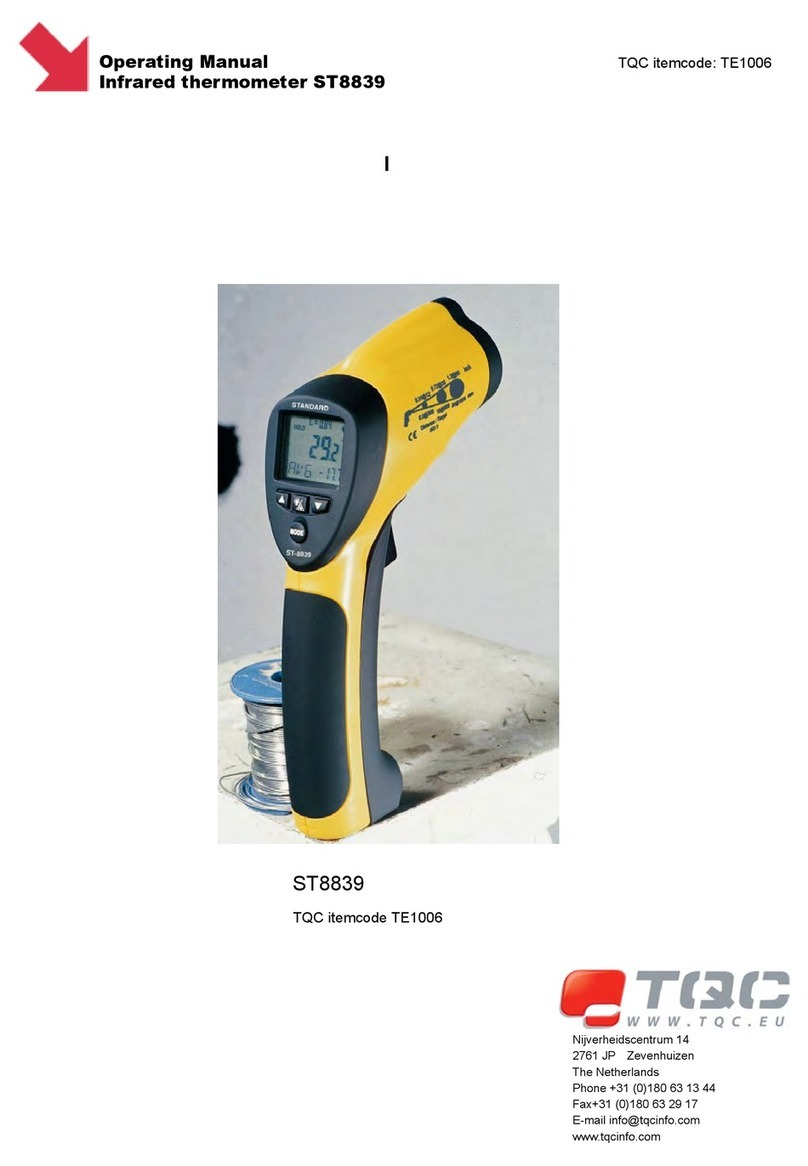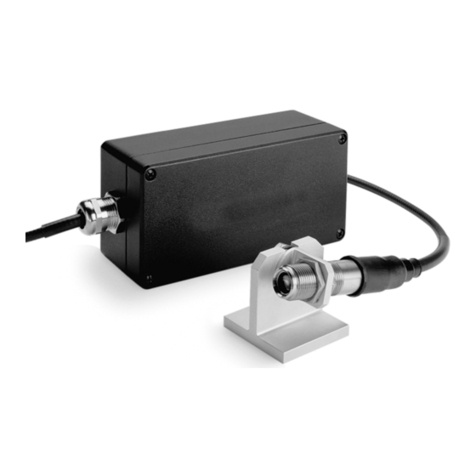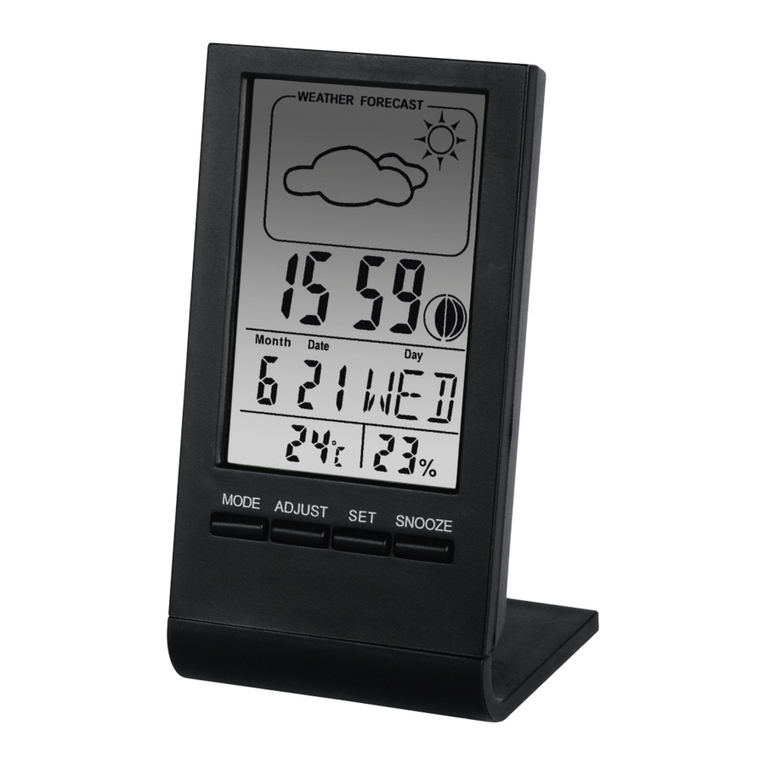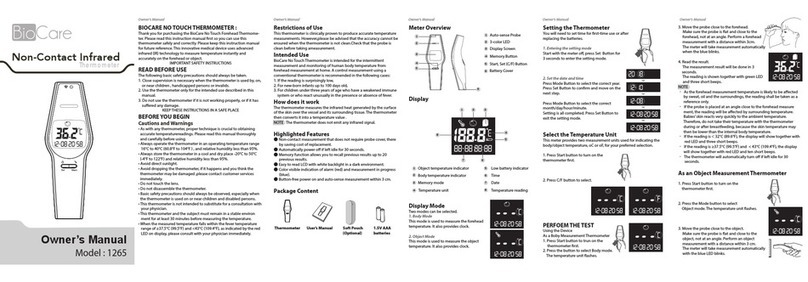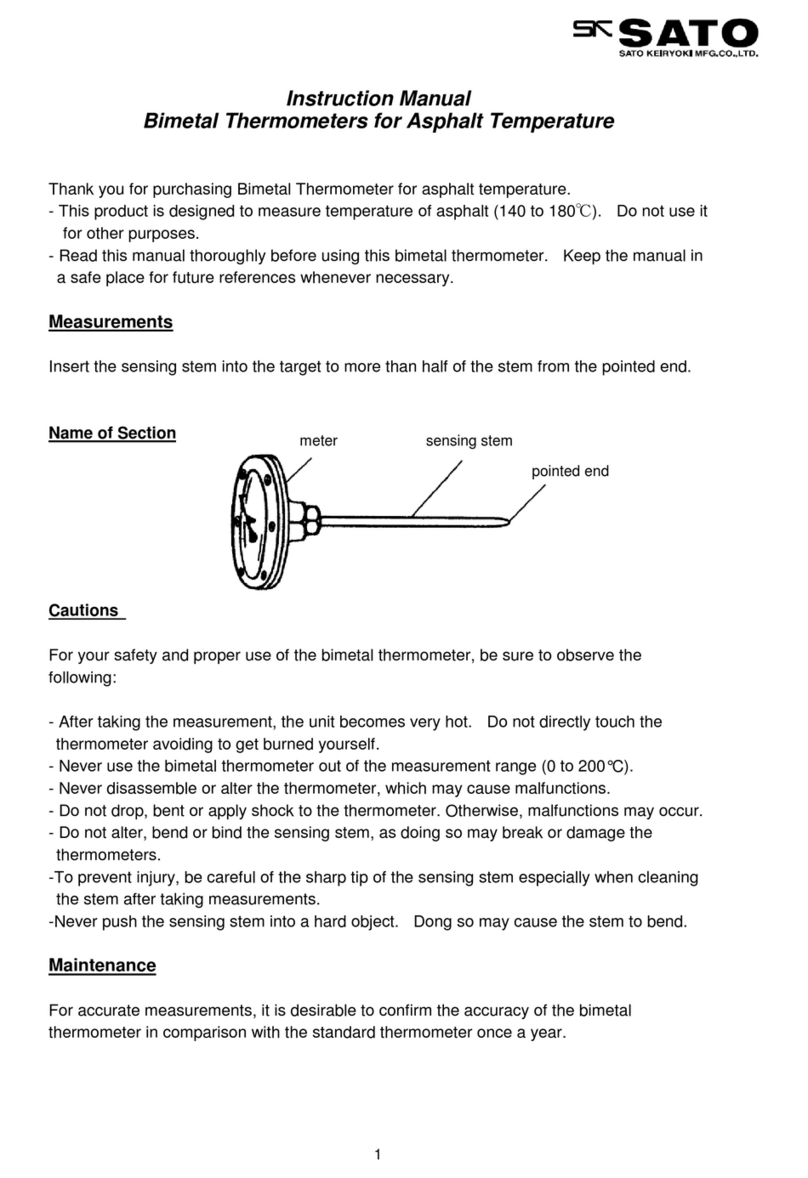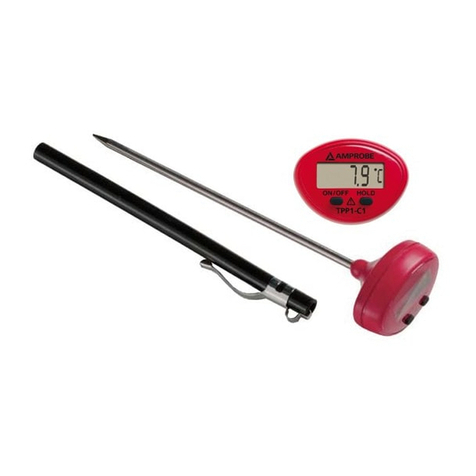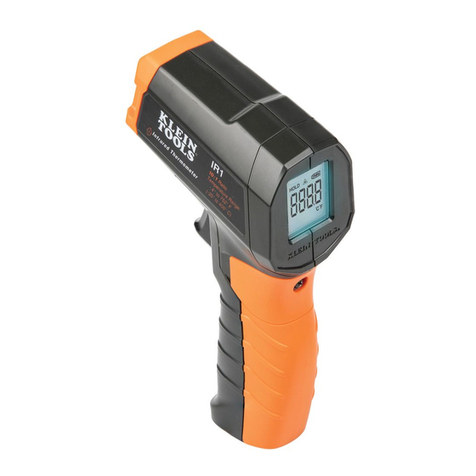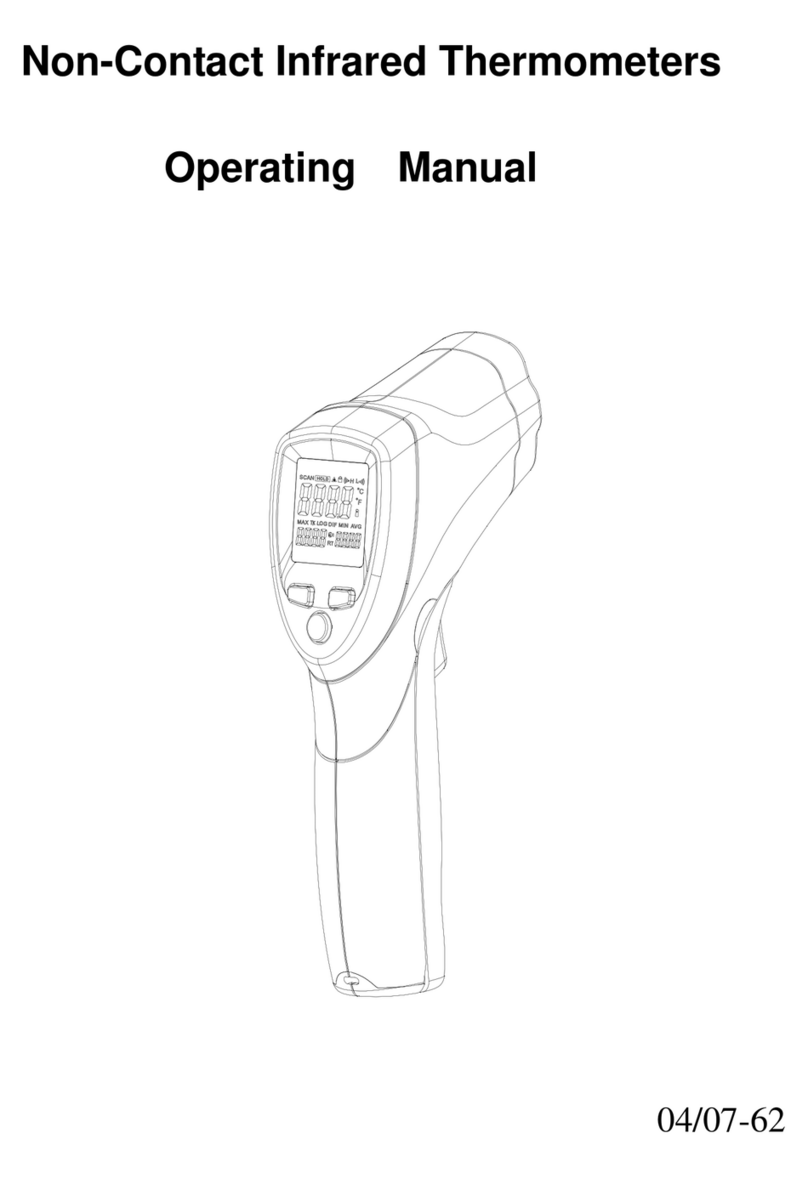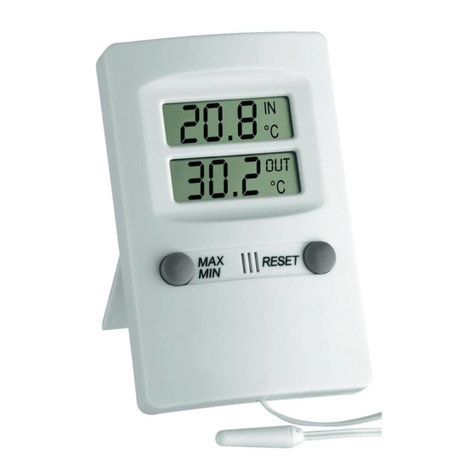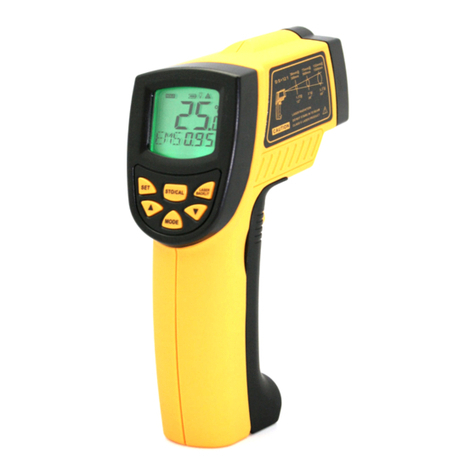TQC TE1005 User manual

1 Features:
•Precise non-contact measurements
•Built-in laser pointer
•Automatic selection range and Resolution to 0.1ºor 1º
•°C/°F switchable button
•Automatic Data Hold &Auto power off
•The meter at 12 inches away measure 1 inch target
•Backlit LCD display
2 Wide range application:
Food preparation, Safety and Fire inspectors, Plastic molding,Asphalt,
Marine and screen printing, measure ink and dryer temperature, Diesel and Fleet maintenance.
3 Field of View
The meter’s field of view is 12:1, meaning that if the meter is 12 inches from the target, the diameter of the object under test must be at least 1
inch. Other distances are shown below in the field of view diagram. Refer to the chart printed on the meter for more information.
LaserBeam
Sensor Beam
Fig: 1
1. SAFETY
zUse extreme caution when the laser beam is turned on.
zDo not let the beam enter your eye, another person’s eye or the eye of an animal.
zBe careful no to let the beam on a reflective surface strike your eye.
zDo not allow the laser light beam impinge on any gas which can explode.
2. SPECIFICATIES
zGeneral specifications
Display 3½ digital LCD screen with backlight
Measuring range / resolution -50.0°C to 750°C /-58.0°F to 1382°F (0.1°C to 200°, 1° over 200°).
Response time Less than 1 second.
Over range indication LCD will show “1”.
Polarity Automatic (no indication for positive polarity); Minus (-) sign for negative
polarity
Emissivity 0.95 fixed value
Field of view D/S = Approx. 12:1 ratio (D = distance; S = spot (Has 90% encircled energy
at the focal point)
Diode laser Output <1mW, Wavelength 630~670nm, class2 (II) Laser product.
Spectral response 8~14µm.
Power off Automatic shut off after apprx. 7 seconds
Operating temperature 0°C to 50°C (32°F to 122°F).
Storage temperature -20°C to 60°C (-4°F to140°F).
Distance(D) to Spot Size(S)
D:S=12:1
3.0@36
mm
inch
16mm
1.0@12 5.0@60
25@300 75@900 125@1500
INFRARED THERMOMETER
TE1005 Instruction Manual

Relative humidity 10%~90%RH operating, <80%RH storage
Power supply 9V battery, NEDA1604Aor IEC 6LR61.
Weigth 290g.
Dimensions 100 x 56 x 230mm.
zInfrared thermometer specifications
Range (auto. selection 0.1°C/1°C) Resolution Accuracy
-50.0°C to -20.0°C ± 5°C;-50.0°C to 200.0°C -20.0°C to 200.0°C 0.1°C ± 1.5% of reading ± 2°C;
201°C to 538°C ± 2% of reading ± 2°C;
539°C to 750°C 1°C ± 3.5% of reading ± 5°C.
Range(auto. selection 0.1°F/1°F Resolution Accuracy
-58.0°F to -4.0°F ± 9°F;-58.0°F to 200.0°F -4.0°F to 200.0°F 0.1°F ± 1.5% of reading ± 4°F;
201°F to 1000°F ± 2% of reading ±°F;
1001°F to 1382°F 1°F ± 3.5% of reading ±9°F.
Note:
Accuracy is given at 18 oC to 28 oC (64
o
F to 82
o
F), less than 80 % RH.
Field of View:
Make sure that the target is larger than the unit’s spot size. The smaller the target, the closer you should be to it. When accuracy is critical, make
sure the target is at least twice as large as the spot size.
Emissivity: 0.95 fixed value
3. FRONT PANEL DESCRIPTION
①IRsensor
②Laser pointer beam
③LCD Display
④°F select key
⑤℃select key
⑥Backlight select key
⑦Laser select key
⑧ Measurement Trigger
⑨ Handle Grip
⑩ Battery Cover
4. INDICATOR
①Digital readout
②Temperature ℃(Celsius)
③Temperature ℉(Fahrenheit)
④Measuring indication
⑤DataHold
⑥LOW battery indicator
⑦Laser Point
⑧ Fixed emissivity (0.95)
1
2
3
6
5
4
7
8
+
9
5
6
3
10
4
8
7
-
¡ã
F
HOLD¡ã
C
SCAN
1
2

5. MEASUREMENT OPERATION
①Hold the meter by its Handle Grip and point it toward the surface to be measured.
②Pull and hold the Trigger to turn the meter on and begin testing. The display will light if the battery is good. Replace the battery if the
display does not light.
③While measuring, the SCAN display icon will appear in the upper left hand corner of the LCD.
④While continuing to pull the Trigger:
a. Push the Laser button to turn on the laser pointer. When the laser is on the laser icon will appear on the LCD over the
temperature. Aim the red beam approximately a half inch above the point of test (pressing the Laser button again turns
the laser off).
b. Select the temperature units (oC or oF) using the oCand oFbuttons.
c. Push the Backlight key to turn on the LCD backlighting function.
⑤Release the Trigger and the HOLD display icon will appear on the LCD indicating that the reading is being held.
⑥The meter will automatically power down after approximately 7 seconds after the trigger is released.
Note: Measurement considerations
Holding the meter by its handle, point the IR Sensor toward the object whose temperature is to be measured. The meter automatically
compensates for temperature deviations from ambient temperature. Keep in mind that it will take up to 30 minutes to adjust to wide ambient
temperatures are to be measured followed by high temperature measurements, some time (several minutes) is required after the low (and
before the high) temperature measurements are made.
This is a result of the cooling process which must take place for the IR sensor.
6. BATTERY REPLACEMENT
①As battery power is not sufficient, LCD will display “ ” replacement with one new battery type 9V is required.
②Open battery cover, then take out the battery from instrument and replace with a new 9-Volt batter
y
and place the batter
y
cover back.
Lowbatteryindicator
Open the battery cove
9Vbattery
7. NOTES:
zHow it Works
Infrared thermometers measure the surface temperature of an object. The unit’s optics sense emitted , reflected, and transmitted energy,
which is collected and focused onto a detector. The unit’s electronics translate the information into a temperature reading which is display
on the unit. In units with a laser, the laser is used for aiming purposes only.
zField of View
Make sure that the target is larger than the unit’s spot size. The smaller the target, the closer you should be to it. When accuracy is critical,
make sure the target is at least twice as large as the spot size.
zDistance & Spot Size
As the distance (D) from the object increases, the spot size (S) of the area measured by the unit becomes larger. See: Fig: 1.
zLocating a hot Spot
To find a hot spot aim the thermometer outside the area of interest, then scan across with an up and down motion until you locate hot spot.
F
¡ã
C
¡ã
-
+
SCAN
HOLD

zReminders
- Not recommended for use in measuring shiny or polished metal surfaces ( stainless steel, aluminum, etc.).See Emissivity
- The unit cannot measure through transparent surfaces such as glass. It will measure the surface temperature of the glass instead.
- Steam, dust, smoke, etc., can prevent accurate measurement by obstructing the unit’s optics.
zEmissivity
Most (90% of typical applications) organic materials and painted or oxidized surfaces have an emissivity of 0.95 (pre-set in the unit).
Inaccurate readings will result from measuring shiny or polished metal surfaces. To compensate, cove the surface to be measured with
masking tape or flat black paint. Allow time for the tape to reach the same temperature as the material underneath it. Measure the
temperature of the tape or painted surface.
Emissivity Values
Substance Thermal emissivity Substance Thermal emissivity
Asphalt 0.90 to 0.98 Cloth (black) 0.98
Concrete 0.94 Human skin 0.98
Cement 0.96 Lather 0.75 to 0.80
Sand 0.90 Charcoal (powder) 0.96
Earth 0.92 to 0.96 Lacquer 0.80 to 0.95
Water 0.92 to 0.96 Lacquer (matt) 0.97
Ice 0.96 to 0.98 Rubber (black) 0.94
Snow 0.83 Plastic 0.85 to 0.95
Glass 0.90 to 0.95 Timber 0.90
Ceramic 0.90 to 0.94 Paper 0.70 to 0.94
Marble 0.94 Chromium oxides 0.81
Plaster 0.80 to 0.90 Copper oxides 0.78
Mortar 0.89 to 0.91 Iron oxides 0.78 to 0.82
Brick 0.93 to 0.96 Textiles 0.90
8. DISCLAIMER
The information given in this manual is not intended to be exhaustive and any person using the product for any purpose other than that
specifically recommended in this manual without first obtaining written confirmation from us as to the suitability of the product for the intended
purpose does so at his own risk. Whilst we endeavour to ensure that all advice we give about the product (whether in this manual or otherwise)
is correct we have no control over either the quality or condition of the product or the many factors affecting the use and application of the
product. Therefore, unless we specifically agree in writing to do so, we do not accept any liability whatsoever or howsoever arising for the
performance of the product or for any loss or damage (other than death or personal injury resulting from our negligence) arising out of the use of
the product. The information contained in this manual is liable to modification from time to time in the light of experience and our policy of
continuous product development.
Other TQC Thermometer manuals
Popular Thermometer manuals by other brands
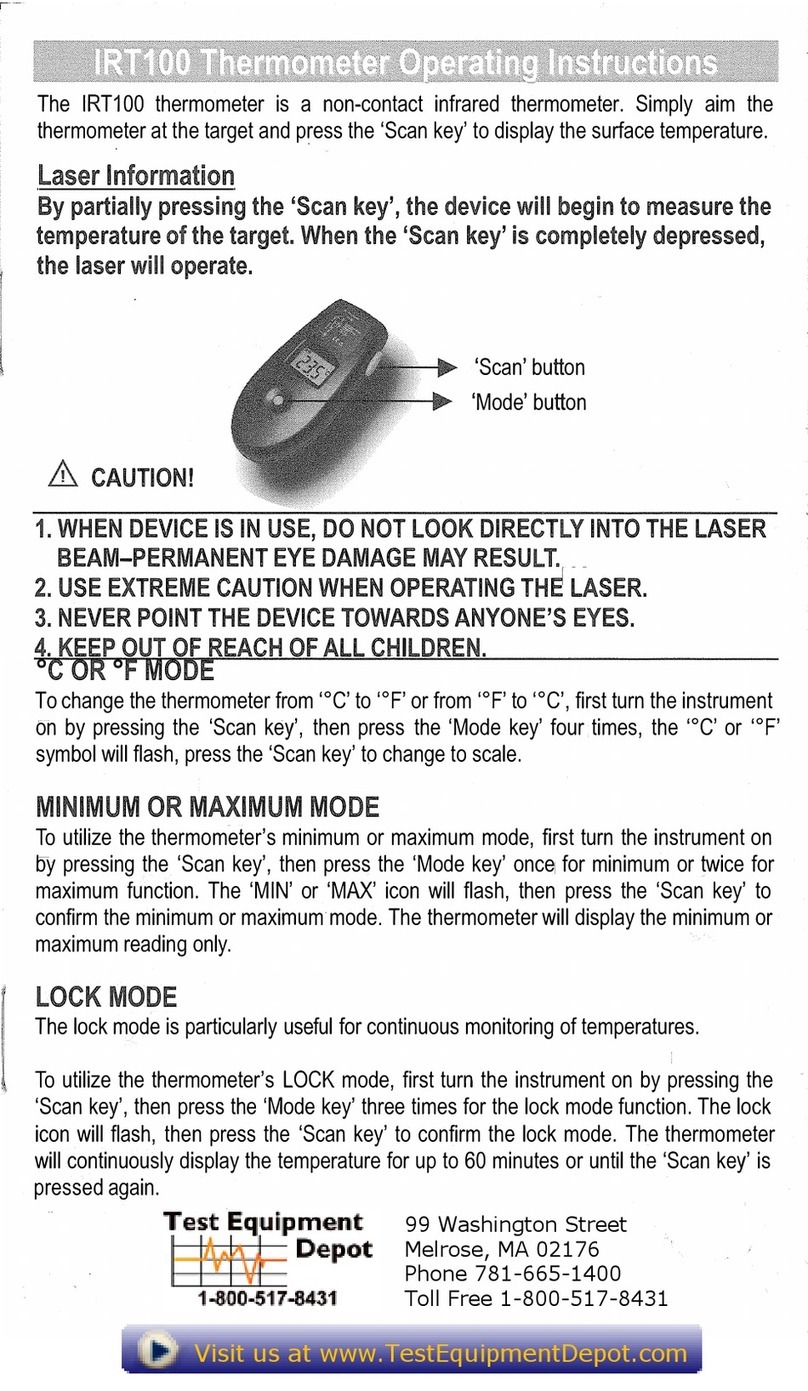
Sperry instrument
Sperry instrument IRT100 operating instructions

Perfect Prime
Perfect Prime TC0370 instruction manual
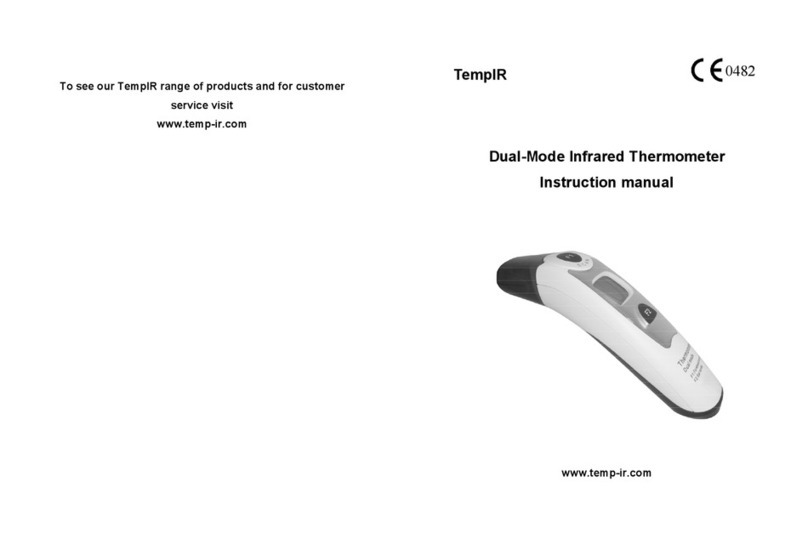
TempIR
TempIR Dual-Mode Infrared Thermometer instruction manual
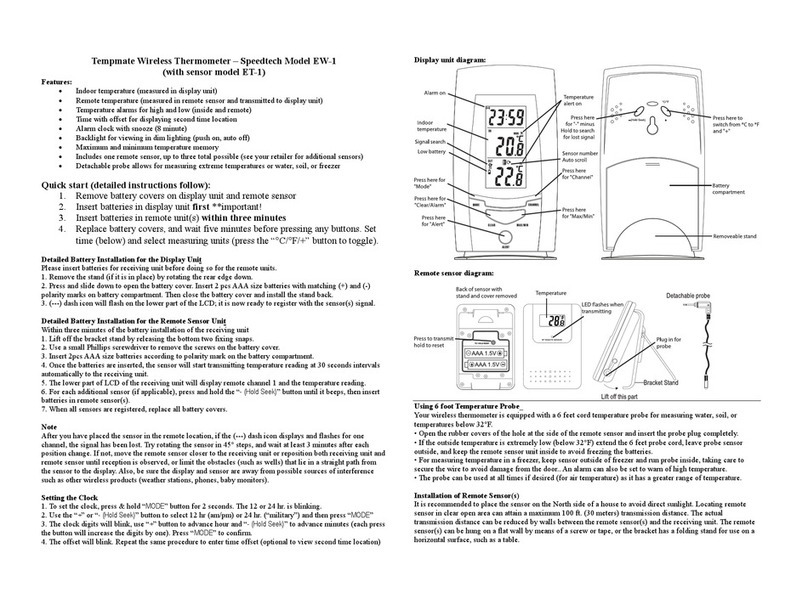
Speedtech Instruments
Speedtech Instruments EW-1 user manual
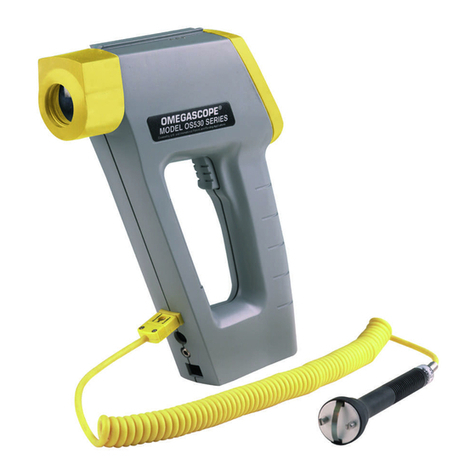
Omega Engineering
Omega Engineering OMEGASCOPE OS523 user guide
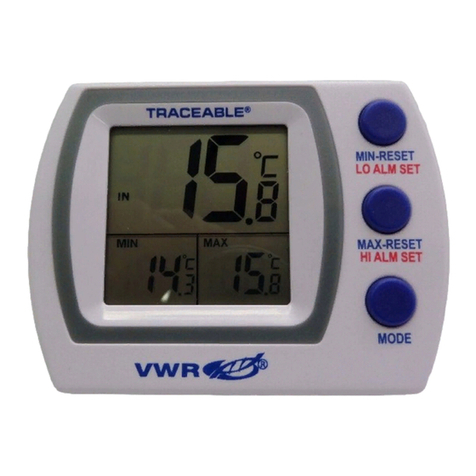
VWR
VWR 12777-838 instruction manual
